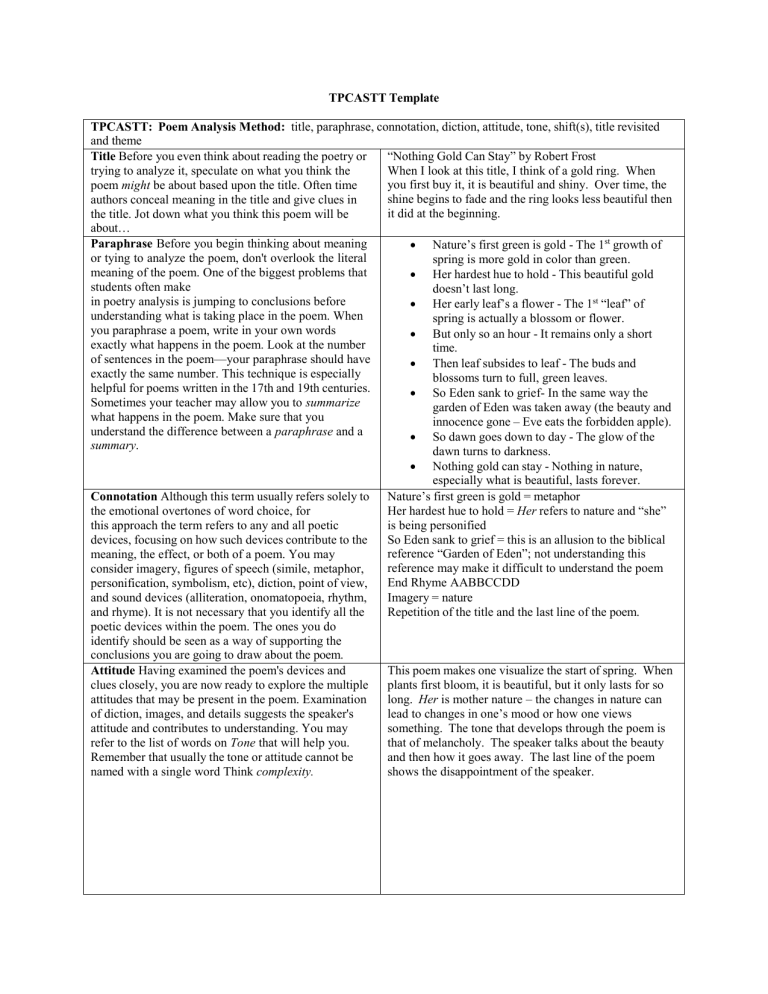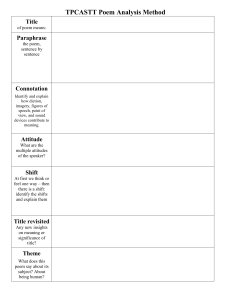
TPCASTT Template TPCASTT: Poem Analysis Method: title, paraphrase, connotation, diction, attitude, tone, shift(s), title revisited and theme Title Before you even think about reading the poetry or “Nothing Gold Can Stay” by Robert Frost When I look at this title, I think of a gold ring. When trying to analyze it, speculate on what you think the you first buy it, it is beautiful and shiny. Over time, the poem might be about based upon the title. Often time shine begins to fade and the ring looks less beautiful then authors conceal meaning in the title and give clues in it did at the beginning. the title. Jot down what you think this poem will be about… Paraphrase Before you begin thinking about meaning Nature’s first green is gold - The 1st growth of or tying to analyze the poem, don't overlook the literal spring is more gold in color than green. meaning of the poem. One of the biggest problems that Her hardest hue to hold - This beautiful gold students often make doesn’t last long. in poetry analysis is jumping to conclusions before Her early leaf’s a flower - The 1st “leaf” of understanding what is taking place in the poem. When spring is actually a blossom or flower. you paraphrase a poem, write in your own words But only so an hour - It remains only a short exactly what happens in the poem. Look at the number time. of sentences in the poem—your paraphrase should have Then leaf subsides to leaf - The buds and exactly the same number. This technique is especially blossoms turn to full, green leaves. helpful for poems written in the 17th and 19th centuries. So Eden sank to grief- In the same way the Sometimes your teacher may allow you to summarize garden of Eden was taken away (the beauty and what happens in the poem. Make sure that you innocence gone – Eve eats the forbidden apple). understand the difference between a paraphrase and a So dawn goes down to day - The glow of the summary. dawn turns to darkness. Nothing gold can stay - Nothing in nature, especially what is beautiful, lasts forever. Connotation Although this term usually refers solely to Nature’s first green is gold = metaphor Her hardest hue to hold = Her refers to nature and “she” the emotional overtones of word choice, for is being personified this approach the term refers to any and all poetic So Eden sank to grief = this is an allusion to the biblical devices, focusing on how such devices contribute to the reference “Garden of Eden”; not understanding this meaning, the effect, or both of a poem. You may reference may make it difficult to understand the poem consider imagery, figures of speech (simile, metaphor, End Rhyme AABBCCDD personification, symbolism, etc), diction, point of view, Imagery = nature and sound devices (alliteration, onomatopoeia, rhythm, Repetition of the title and the last line of the poem. and rhyme). It is not necessary that you identify all the poetic devices within the poem. The ones you do identify should be seen as a way of supporting the conclusions you are going to draw about the poem. Attitude Having examined the poem's devices and This poem makes one visualize the start of spring. When clues closely, you are now ready to explore the multiple plants first bloom, it is beautiful, but it only lasts for so attitudes that may be present in the poem. Examination long. Her is mother nature – the changes in nature can of diction, images, and details suggests the speaker's lead to changes in one’s mood or how one views attitude and contributes to understanding. You may something. The tone that develops through the poem is refer to the list of words on Tone that will help you. that of melancholy. The speaker talks about the beauty Remember that usually the tone or attitude cannot be and then how it goes away. The last line of the poem named with a single word Think complexity. shows the disappointment of the speaker. Shift Rarely does a poem begin and end the poetic experience in the same place. As is true of most us, the poet's understanding of an experience is a gradual realization, and the poem is a reflection of that understanding or insight. Watch for the following keys to shifts: • key words, (but, yet, however, although) • punctuation (dashes, periods, colons, ellipsis) • stanza divisions • changes in line or stanza length or both • irony • changes in sound that may indicate changes in meaning • changes in diction Title revisited Now look at the title again, but this time on an interpretive level. What new insight does the title provide in understanding the poem. Theme What is the poem saying about the human experience, motivation, or condition? What subject or subjects does the poem address? What do you learn about those subjects? What idea does the poet want you take away with you concerning these subjects? Remember that the theme of any work of literature is stated in a complete sentence. The words But and So (2X) indicate a shift in the tone of the poem. It’s like when someone gives you good news and then there’s a “but”. The speaker is trying to express how beauty fades and is not eternal. Now that I’ve read the poem, the title refers to the colors of spring and how they do not last, how everything changes in time. After reading The Outsiders by S.E. Hinton, I have another perspective on the poem; In the novel “stay gold” refers to innocence. When you’re young, you’re gold. When you have interests that no one else seems to have, that’s gold. The theme of the poem relates to the circle of life. The poem relates it to nature: flower, leaf, bud, and fruit, into the full life that includes loss, grief, and change. Nature is like life. Beauty exists but declines in time.


